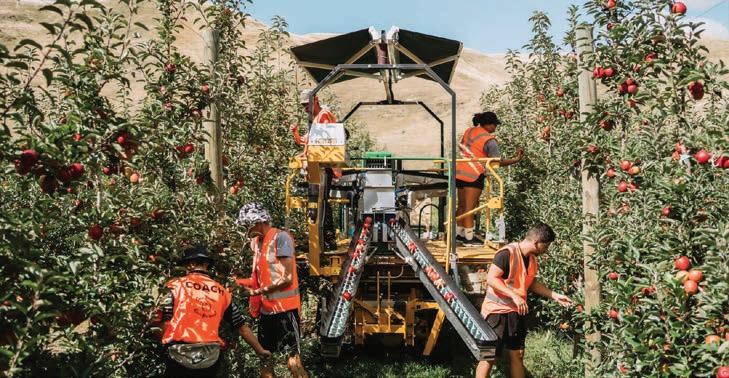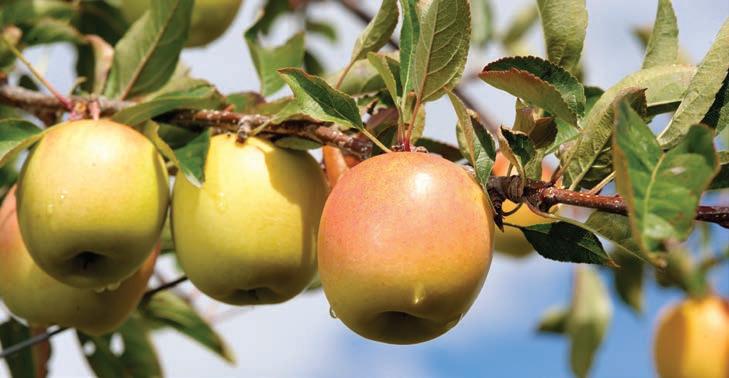
5 minute read
2-D growing systems prove their worth
Fourteen years since the first commercial 2-D orchards were planted, AgFirst director, Craig Hornblow, says they can provide long-term growing benefits.
By Rose Mannering
There is not one iteration of a 2-D system, it is a constantly moving target, Craig says. However, he believes a simple, narrow row produces the greatest accessibility and is the most productive.
Due to the high capital expenditure, with a development cost of $200,000 a hectare, it is important to consider the longevity of the block. Investment analysis has been carried out for 15 years but most orchards at a reasonable row spacing and in good condition, can be grafted to another variety, or even worked over three or four times. “A development cost of $200,000 a hectare can stretch to a 30-year horizon,” Craig says. Careful thought needs to go into the structure and risk. Hail insurance has got to the point where it is almost unaffordable, and Craig believes hail netting will be a big part of the future. Ground conditions become an important consideration, with more frequent machinery passes and high technology equipment for picking or scanning the canopy. Longevity of rootstock is also critical. There are now two or three rootstocks soon to be available that will offer a whole range of benefits going into the future. “Be wary of ones that grow strongly early but then stall and behave much worse than M9 – the current industry standard,” Craig says. Disease and pest resistant qualities will also be important for future orchard developments.
The oldest 2-D systems are now 14 years old and every variety in commercial production has been tried on this system. Most varieties can be adapted to a 2-D system, the most difficult to date has been Pink Lady. investment for individual orcharding operators. Narrow rows maximise the benefit of picking platforms.
The objective metrics are to fill the wires. Current systems now vary between six and eight wires. “It becomes a matter of micro-managing every fruiting window to deliver the desired number of fruits,” says Craig. The narrower the 2-D system, the better. It should be no wider than 35 – 40 cm mid-season, and narrower rows allow light to penetrate through the whole canopy. “You need to be able to see through three to five rows mid-season.”
Another way to judge whether the level of light penetration is good is to lay Extenday – a type of reflective cloth – then see if there is a 50% shading pattern on the cloth (or measured light of 800µmols). “It is all about managing windows and getting texture into the canopy to allow light transmission,” says Craig. “This will give you excellent consistent fruit quality.” Leaf blowing can be used to manage late season light transmission in the canopy. Craig says picking platform sales have been “massive” in the past twelve or so months, representing a big capital
Labour demand in growing pipfruit is one of the biggest considerations and equates to one person per hectare. At peak demand at the end of season, this may increase to three people per hectare. If a picker needs to climb 1.5-metres up a ladder to pick the tops of the trees and there is a planting density of 2,000 trees per hectare, this is equivalent to climbing 3,500 metres. Putting this in climbers’ terms, that is the equivalent to climbing Mt Everest. “One bin weighs 400 kg,” says Craig. “If a worker picks four bins a day, that is 1,600 kg a day. In a five-day week, one worker picks 8,000 kg, and in a 12-week season that is 96,000kg.” SF_021_SFInBoxNZHalfPageAd2_TheOrchardist.qxp_SF_021_SFInBoxNZAdvertorial_TheOrchardist 11/17/21 1:33 PM Page 1
Pack Freshness with Confidence
Latest addition to the proven SmartFresh™ portfolio of solutions for apples and kiwifruit.
The original post-harvest choice to maintain consumer-desired produce freshness, flavour and quality is available for convenient “on the move” fruit quality protection. SmartFresh InBox is an easy-to-use sachet that delivers AgroFresh’s proven SmartFresh technology to inhibit the negative effects of ethylene and maintain fruit quality throughout the distribution chain.

Simply place the SmartFresh InBox sachet in the final packaging as soon as possible after harvest and it is ready to be shipped immediately or stored depending on your needs.
• Ideal for pick, pack, ship • Protect shipments • Target new business opportunities
Actual size: 40.6mm x 45.7mm
FOR APPROPRIATE USE BY CROP, PLEASE CONTACT AGROFRESH NZ LTD: Jane Turner, Commercial Lead JaneTurner@agrofresh.com, 021 777 024

Mobile picking platforms produce a smaller efficiency gain of 20% for experienced pickers, but for inexperienced pickers the gain is closer to 40%. 2-D growing systems mean chemical thinning can be eliminated due to the ease of thinning mechanically. Truly robotic picking systems are some time away, Craig says. Productivity of different growing systems within the 2-D footprint indicates the V-system can produce higher yield.
PRODUCTIVITY 2-D system & V-system 2-D Single leader V-System
Fruiting Wood
33km 42km
Yield 2.7kg/m 90 tonnes/ha 113 tonnes/ha
Yield 3.0 kg/m 100 tonnes/ha 126 tonnes/ha
Mature 2-D systems are yielding between 83 and 125 tonnes, and consistency through the canopy is a big plus. Pink Lady has proved to be the most challenging to grow on a 2-D system. Hoddys Fruit Co Ltd general manager, Andrew Kininmonth, says extensive use of the 2-D growing system on his orchards has been driven by a desire to produce high quality fruit which delivers a consistent eating experience. Trees tend to be less biennial and produce more spur wood. For staff working on platforms, it is straightforward to teach the rules making each task easier. “We spend a lot of time during the winter doing detailed pruning, which makes the rest of the year easier,” he says. Practical learnings from the 2-D system for commercial growing include having longer rows. Andrew believes 100-metre rows are too short and in future he plans to lay conduit down the rows in preparation for electric vehicle (EV) platforms that may need charging during the day.
A fragmented approach to the development of machinery and systems to use in 2-D growing systems is seen as a barrier to progress. Co-founder of Hortworx, Rob Elstone, says the industry needs to work out how to collaborate so design effort is not wasted. “Do we develop a machine that goes down narrow rows [to fit the Future Orchard Planting Systems (FOPS) developed by Plant & Food Research]? We don’t want to develop what you don’t want,” he says. It is exciting times for technology development in pipfruit but a mindset change is needed so that different growing groups can work together.










